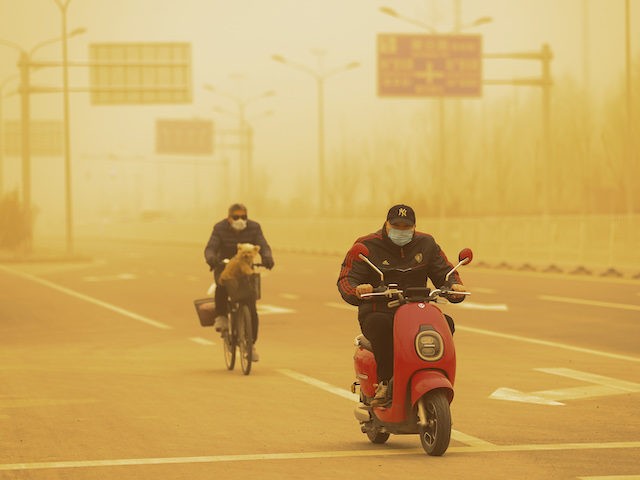China’s worst sandstorm in a decade blanketed Beijing and much of the country’s north in yellow dust on Monday.
The sandstorm has impacted 12 northern Chinese provinces so far, including China’s Inner Mongolia Autonomous Region, where at least six people died and 80 people are missing as of Monday due to the storm, state broadcaster China Global Television Network (CGTN) reported on March 15.
Beijing’s two main airports canceled over 400 flights citing low visibility and high winds over the weekend as dust rolled into the national capital, while the city’s schools called off outdoor activities on Monday.
The dust storm is China’s “most intense” and widest-ranging in the past ten years, according to a statement released by China’s National Meteorological Center on March 15.
Warm, dry weather in northern China combined with strong winds from Mongolia’s Gobi Desert to form the sandstorm, Zhang Bihui, an official at China’s Meteorological Administration, said during a press conference on Monday.
“[V]isibility in most areas of Beijing is about 300 to 800 meters,” the Beijing Ecological Environment Monitoring Center reported on March 15.
“Many cities recorded a drastic increase in air pollutants known as PM10 — particles up to 10 micrometers in diameter that can cause respiratory diseases. In Beijing, concentrations exceeded 8,000 micrograms per cubic meter at some measuring stations, or about 100 times the city’s average reading,” the Chinese state-controlled Sixth Tone news site reported on Monday.
Hebei province – which surrounds Beijing – and the Inner Mongolia Autonomous Region are the two hardest-hit areas by the sandstorm. Meteorological authorities in those regions recorded “PM10 concentrations above 10,000 micrograms per cubic meter” on Monday according to Sixth Tone, citing a report by the Chinese Communist Party newspaper People’s Daily.
Sand from China’s western deserts blows eastward in the springtime, forming regular yellow dust storms known to reach as far east as Japan. Massive planting efforts to promote anti-desertification reduced the impact of the storms on China’s urban centers in recent years. The expansion of China’s cities and industries, which promotes increased strip mining and overgrazing, has simultaneously increased pressure on China’s environment, however, meaning the country still grapples with sandstorms. Inner Mongolia is especially prone to extreme weather conditions due to its mixed composition of both desert and grassy steppe.
An Inner Mongolia resident named Yang Qian told Sixth Tone that China’s latest sandstorm made traffic lights “barely visible” on Sunday night, adding that she “woke up with sand and dust all over the floor of her home” by Monday morning.
“The visibility outside this morning was only about 20 meters,” Yang, who lives in Baotou city, said. Baotou canceled all kindergarten, primary, and middle school classes on Monday.

COMMENTS
Please let us know if you're having issues with commenting.